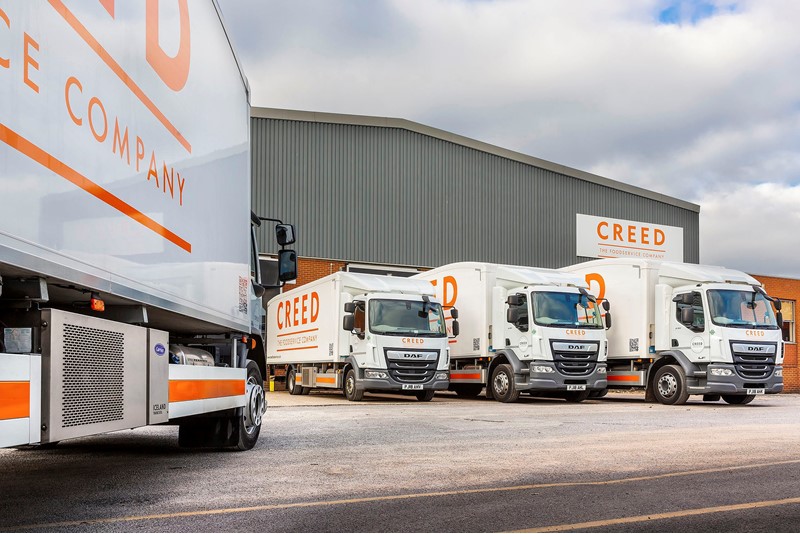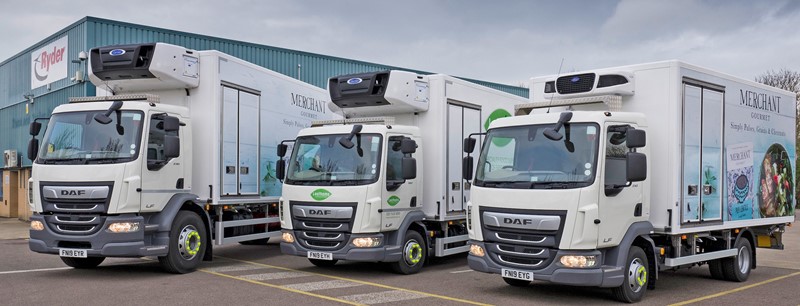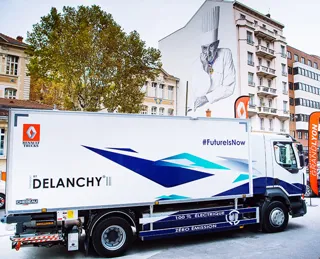Although diesel-fired fridge units are becoming cleaner, they continue to produce potentially harmful emissions. As a consequence, fleets transporting temperature-controlled goods are increasingly looking at other, more-environmentally-friendly, ways of keeping their loads cool.
Swedish manufacturer Hultsteins has come up with one possible solution. It has developed a refrigeration system powered by a hydraulic pump mounted on – and driven by – the truck’s own engine, which means there is no need to fit a separate donkey engine.
The system is designed so the power delivered to the fridge is constant, regardless of whether the vehicle is cruising down the motorway or idling in congested urban traffic. Making the truck’s engine do two jobs rather than one means big reductions in CO2, NOx and particulate output says UK distributor, Cold Connect, not to mention lower fuel and maintenance bills.
Although new to the UK, the technology Hultsteins is using dates to the early 1960s. It can be fitted to trailers, but is primarily designed for 7.5- to 26-tonne rigids.
Cold Connect also offers a clip-on hydraulic-drive generator which can be connected to a tractor unit engine’s power take-off and used to drive a trailer’s fridge.
Hultsteins and Cold Connect are by no means the only businesses looking to minimise the environmental impact of van and truck fridges.
Dearman Hubbard has developed a package powered by the novel Dearman engine, which is driven by the expansion of liquid nitrogen. As a consequence, all that comes out of the exhaust is air or nitrogen, says the company.
Replacing a diesel fridge engine with a Dearman engine is claimed to reduce a refrigerated vehicle’s overall NOx emissions by more than 70% and particulate emissions by 90%.
That is because comparatively lightly regulated diesel-powered fridges may emit six times the NOx and up to 29 times as much particulate matter as Euro VI truck engines.
That said, the new Stage V transport refrigeration emission regulations which came into force in January have obliged manufacturers to introduce cleaner fridge engines, with particulate emissions down 40%.
Carrier Transicold’s engineless Iceland 18 Twincool refrigeration package is finding favour with a number of operators, including Reynolds, one of the country’s biggest fruit and vegetable suppliers.
Installed in a Paneltex-bodied Iveco Stralis 26-tonner which went into service earlier this year, it, too, relies on a hydraulic pump driven by the truck’s engine.
Thanks to Carrier Transicold’s Eco-Drive power module, the variable-displacement pump connected to the truck engine’s power take-off drives an electric generator which delivers constant power to the fridge, no matter what speed the Stralis is travelling at.

It is the first engine-less system to appear in the Reynolds fleet.
As well as reducing exhaust emissions, the unit has a further advantage. Because it does not have an engine of its own, sound levels are less than 60 dB(A); a big plus if deliveries are being made early in the morning or late at night.
This means it meets the PIEK noise standard.
Introduced in the Netherlands in 2003, PIEK was developed as a consequence of pressure to lower the noise levels made by out-of-hours deliveries. They should not exceed the noise level of a normal conversation, it was decided.
There is another plus – the Iceland is under-mounted.
While under-mounts are potentially more vulnerable to road dirt and damage, they have less impact on a truck’s aerodynamics than nose-mounted systems and are easier to access when they need to be maintained.
Technicians called on to service or repair a nose-mounted unit have to work at height, which poses health and safety risks.
Iceland has also been installed in a dozen temperature-controlled Daf LFs operated by Creed Foodservice, the Staverton, Gloucestershire-based company and supplied through refrigerated vehicle rental specialist Petit Forestier.

Full refrigeration when idling
Creed operations controller Richard Frost is especially pleased with its ability to provide 100% refrigeration capacity at idle speed given that some of the routes Creed services out of its depots at Ilkeston, Derbyshire, and High Wycombe, Buckinghamshire, in addition to its HQ, are often heavily congested.
“The trucks are helping to future-proof our fleet and ensure we are using the latest transport refrigeration technology with a much smaller environmental footprint,” Frost says.
Creed delivers a wide variety of foodstuffs and non-food products to caterers in the hospitality, leisure, care and education sectors.

Elsewhere, Waitrose is determined to do all it can to minimise any harm to the environment. The upmarket supermarket chain is trialling an engine-less Carrier Transicold multi-temperature Syberia Twincool on a Scania P280 powered by natural gas.
The trial will last 12 months and will document the extent to which the vehicle can lower CO2 emissions and improve fleet efficiency. The results are likely to guide Waitrose’s future fleet specifications.
The initiative is being funding through Innovate UK, the Government’s innovation agency. Waitrose is working alongside researchers from the University of Cambridge’s Centre for Sustainable Road Freight as part of a year-long low-emissions freight and logistics initiative.
At the same time as acquiring the Stralis with the Iceland refrigeration package, Reynolds added an electric Kangoo Van ZE to its fleet converted to temperature-controlled specifications by CoolKit and equipped with Carrier Transicold’s electric Neos 100 refrigeration technology.
CoolKit has installed a separate electric power source so Neos 100 does not drain power from the van’s traction battery pack and shorten its range.
Both the Stralis and the Kangoo were supplied to Reynolds through SHB Hire (which is being acquired by Enterprise Rent-A-Car) and have been acquired for use on multi-drop work within central London’s new Ultra-Low Emission Zone (ULEZ).
Carrier Transicold is not the only company to produce electric fridges. GAH does, too.
Its product was fitted to an electric 7.5-tonner built by Paneltex using an Isuzu N75 chassis on display at the Commercial Vehicle Show earlier this year. The truck was equipped with a Paneltex temperature-controlled body.
GAH’s electric fridge technology was also in evidence elsewhere on the Paneltex stand; on a 4.25-tonner converted to battery power by Turkey’s BD Automotive, and partly based around a Fiat Professional Ducato.
“Electrification is almost like a new religion at present so far as refrigeration is concerned,” says Stephen Williams, UK sales manager at Thermo King. “Everybody is getting into it.”
Suitable for single- and multi-temperature applications, Thermo King’s new electric E-200 fridge, launched at last year’s Hanover Commercial Vehicle Show, was due to go into production at the time of writing.
Delivery work in Spain
Thermo King has trialled its B-100 ECO electric fridge unit on an electric Citroën Berlingo owned by rental group Northgate, and employed on chilled local delivery work in Spain.
The unit is powered by the vehicle’s 12v auxiliary battery rather than its own dedicated battery pack and, while the Berlingo’s range between recharges is reduced, the reduction is modest, according to Thermo King.
An eight-hour working day with 32 door openings lasting a couple of minutes apiece cuts the range by from 5% to 8.5%. That is a cut most temperature-controlled fleets can probably live with, it says.
After all, the van’s ability to run on battery power means it should face few, if any, restrictions when making deliveries in urban areas that impose local limits on emissions. A vehicle’s range can, of course, be affected by payload, driving style, and weather conditions.
Electric refrigeration systems can be fitted to diesel as well as to electric commercial vehicles. Doing so brings some key advantages, says Williams.
Because they do not depend on a compressor directly driven by the vehicle’s own engine, they do not prevent the cab from being air-conditioned.
Fit an engine-driven fridge unit to a diesel, and any stop/start system installed may have to be isolated so that the refrigeration is not continually cutting in and out. Deploy an electric one instead and it can be equipped with its own hold-over battery so it operates no matter whether the engine is running or not.
Other approaches to cutting fridge emissions include fitting eutectic beams. Charged overnight from off-peak electricity, they are reliable, quiet, energy-efficient and suitable for both chilled and frozen work, but can impose a weight penalty.
Linde’s Frostcruise cryogenic refrigeration represents another option.
Liquid nitrogen stored in an insulated on-board tank at -196C is piped through a heat exchanger. This causes it to evaporate, releasing its cooling power, and fans blow the cold air around the load area.
As with eutectic beams, there are no diesel emissions.
A further option is to retain the fridge unit’s own engine, but run it on compressed natural gas (CNG) rather than diesel.
Carrier Transicold has come up with a version of its Supra multi-temperature refrigeration system that uses the fuel. Benefits include reductions of up to 95% in particulate emissions and up to 70% in NOx emissions compared with diesel, says the company.
CO2 output is down by up to 20%, and down by between 80% and 95% if you use biogas. Fit a CNG-fuelled Supra to a truck with an engine powered by CNG and you can use a single fuel inlet says Carrier, even though the fridge engine has its own gas tank.
CNG engines are quieter than diesels, and the CNG Supra is PIEK-compliant. Noise levels have been cut further through the use of indirect air entry and a special top cover designed to cut acoustic vibrations plus integrated foam sound insulation on the unit’s doors.
Leasing and rental options

The earlier references to Petit Forestier and SHB Hire highlight the fact that, as with any other type of commercial vehicle, a high percentage of temperature-controlled vans and trucks are sourced through rental and contract hire companies.
London-based food distributor Leathams has chosen that route, acquiring a mixed-weight fleet of Dafs from Ryder comprised of LF230 18-tonners, LF180 12-tonners and LF 150 7.5-tonners earlier this year. They deliver frozen and chilled foods six days a week to customers located within and around the M25.
“We go to some of London’s best-known cafés, restaurants and pubs,” says operations director, Mark Ballard. “On average the Dafs make from 20 to 30 drops daily each, with deliveries ranging in size from a box up to a pallet.
“The mileages they do aren’t particularly high, but the number of hours worked is significant.”
That is because they spend a lot of their time inching along in the capital’s heavy traffic.
Built by Solomon Commercials, the dual-compartment bodies fitted to the trucks are all equipped with Carrier Transicold’s Pulsor multi-temperature E-Drive refrigeration system.
It uses an engine-driven generator delivering constant electric power to a variable-speed hermetic compressor via an inverter. The compressor’s capacity remains constant regardless of engine speed.
“We wanted a fridge that would achieve maximum performance even when the truck is stationary,” says Ballard. “With traffic in London often at a standstill the fridge must be able to perform efficiently even at very low rpm.”
The Dafs are all equipped with a telematics system sourced from SevenEye that tracks temperature and door openings.
“We increased the number of 12-tonners this time round because the average loads we carry are getting heavier so it’s more efficient for us to run bigger vehicles,” Ballard says.
Telematics monitors temperature
Telematics has a massive impact on the quantity and quality of information temperature-controlled fleets can glean from their vehicles.
Body and trailer builder Schmitz Cargobull has introduced a new generation of hardware under the CTU-3 banner. It allows all of a refrigerated body’s key features to be connected to a central on-board unit so that they can be monitored remotely.
It can incorporate a temperature recorder linked to a wireless LAN module. This means there is no need for a recorder to be mounted externally where it risks being damaged or possibly stolen.
Schmitz Cargobull has also launched TrailerConnect Portal 2.0.
It allows all the data gleaned by the vehicle’s telematics system to be displayed online in a transport manager’s office many miles away, including the status of the body’s doors.
They can be locked and unlocked remotely – a useful security feature if you are transporting pharmaceuticals for example – and the fridge unit’s temperature can be set remotely, too.
If an important component appears to be about to fail then CTU-3 will relay a warning. Action can then be taken; hopefully before it packs up.
Operating the most environmentally-friendly fleet in the country is of little use if the deliveries it makes are not managed efficiently. To achieve that goal, Greggs has adopted Paragon’s Multi Depot routing and scheduling software.
The bakery-food-on-the-go retailer runs 250 temperature-controlled 18-tonners that make 3,500 deliveries to its 1,800-plus shops daily.
Planning deliveries has become more complex in recent years, it reports, due to time-sensitive access restrictions and extended opening hours at many shops bidding to handle a growth in the breakfast trade.
“We’re using Paragon’s software to regularly review the efficiency of our multi-drop route planning across the UK as well as remodel specific areas of our operation,” says Greggs group logistics manager, Richard Penna.
For example, when Greggs shut its Edinburgh bakery and decided to consolidate all its Scottish baking activities at its Glasgow site, the company decided to use Multi Depot to redesign its distribution set-up.
Previously the company had run 35 18-tonners split between the two bakeries. They delivered to all 260 of its Scottish shops twice a day.
Changing driver shifts
Paragon helped Greggs cut its Scottish fleet to 24 by, among other things, optimising its multi-drop route plans and changing drivers shifts. Fleet utilisation is up by more than 30%, nearly 900 miles a week have been taken out of its routes and its fuel bill is down in excess of 2%.
That equates to an annual CO2 reduction of around 35 tonnes.
Van refrigeration systems will be impacted by the new Worldwide harmonised Light vehicle Test Procedure (WLTP) which will apply to all newly-registered light commercials from next September onwards.
Vehicle manufacturers will have to approve all fridge units installed prior to registration, warns PSA UK head of national specialist fleets, Richard Abbott.
“That’s because the fridge unit will affect the vehicle’s fuel usage and thus its WLTP figure,” he points out.
It is, of course, possible to skirt around WLTP in this instance: get the van registered first, then have it refrigerated thereafter.
However, that will not be possible if you want to fit a refrigerated body to a chassis cab because the rules treat chassis cabs as incomplete; and incomplete vehicles cannot be registered.




















Login to comment
Comments
No comments have been made yet.